人教版七年级英语下册Unit3sectionB
人教版英语七年级下册Unit 3 Section B(2a-2d)新版课件
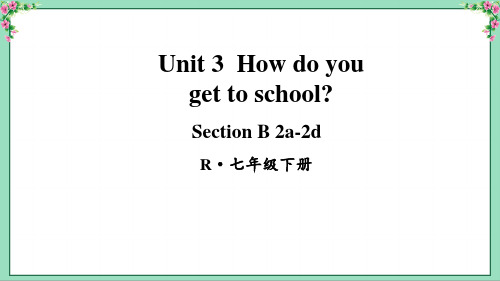
Tips: First understand the questions, then find the answers in the text.
Read Para. 2 & Para. 3 and fill in the blanks.
to understand the general idea of the passage.
Look at the layout(布局)of the story and answer.
➢Where can you see the story? A. In a newspaper. B. In a magazine. C. In a book.
Careful-reading
Read Para. 1 and judge the sentences “T” or “F”.
T 1. For many students, it’s not hard to get to school. F 2. For the students in one small village in China, it’s
Tips: Sometimes, we can judge the type of article by its layout.
Fast-reading
Read the news story from some years 2b ago and choose the best title for it.
Learn to guess the main idea of the passage and talk about how to get to places.
人教版初中英语七年级下册Unit 3 Section B名师课件(三课时)

Practice
A: How does he get to school? B: First, he ...
Then he ...
Practice
A: How does he get to school? B: First, he rides a bike to the subway station.
Their dream is to have a bridge. I think their dream can come true. Maybe the government can build a bridge for them.
1. For the students in the village, itdifsfic_u_lt_______ to get to school. It is (not)+ adj. + to do sth.
For example
A: How do you get to school? B: First, I ...
Then I …
Practice
A: How does he get to work? B: First, he walks to the bus stop.
Then he takes a bus to work.
Review How do you get to school? How long does it take?
18 minutes
I take a taxi to school. I get to school by taxi. It takes about 18 minutes.
人教版七年级英语下unit3SectionB
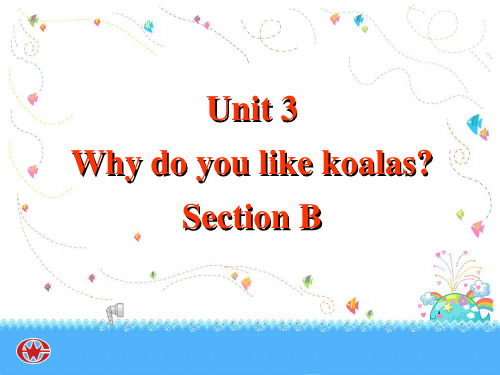
Section B
3a Read the description and match them with the animals.
Molly This is Molly. She is
twelve years old. She is from Africa. She likes to play with her friends and eat grass.
fruit. 改为eat或to climb → climbing 8. Penguins from the South Pole.
前面加are或come 9. —What do you like elephants? Why
—Because they are friendly. 10. We can see many animal in the zoo.
5. The music sounds r_e_l_a_x_in_g_ (relax).
Ⅲ. 根据短文及首字母提示, 补全单词。
This is Larry. He’s (1) f _r_o_m_ Africa. He’s six (2) y____ eoaldr.sHe is (3)l___ . Hazey usually (4)s_le_e_p_s20 hours every day. He likes (5)e_a_ti_n_g_ meat, and he likes to (6)p_la_y_ with his friends. He’s kind of popular in the (7)z_o_o_. Many people like this interesting (8)a_n_im__a_l_.
人教版七下英语Unit3第4课时(SectionB 2a-2d)

Role-play the conversation in 2c. Reporter: How do you go to school, Liangliang? Liangliang: I go on a ropeway to cross the river to school. Reporter: Are you afraid? Liangliang: No, I’m not. Because I love my school and my teachers. I like to play with my classmates at school. Reporter: Is it difficult for you to go to school? Liangliang: Yes, it is. Reporter: Do you want to have a bridge? Liangliang: Yes. It’s our dream. Reporter: I’m sure your dream can come true.
A. How to Get to School √B. Crossing the River to School C. Going to School Is Fun
Read the story again and answer the questions. 1. How do the students in the village go to school?
•for many students, walk/ride a bike/ by bus/ by train •for the students in one small village in China, it is difficult (过渡句) •a very big river, no bridge, the river runs too quickly,
人教版英语七年级下册Unit3 SectionB 教材知识详解

Unit3 SectionB 教材知识详解1. Mary wants to know what he thinks of the trip.玛丽想知道他认为这段旅程怎么样。
(1)这是一个含有what引导的宾语从句的主从复合句,主句的主语是Mary,谓语是wants to know,宾语是一个特殊疑问句,原句应为“What does he think of the trip?”,但在宾语从句中,从句的语序要用陈述语序,其中疑问词仍在句首,位置不变;另外,宾语从句的时态与主句的时态要一致。
如:I know where you live.我知道你住在哪儿。
Thomas wants to know how she gets to school.托马斯想知道她怎样到学校。
(2) think of意为“认为;考虑”。
of为介词,其后可接名词、代词或动名词作宾语,在表示“认为……怎么样”时,可与think about互换。
如:—What do you think of/about the school trip?你认为这次学校郊游怎么样?一It’s great.非常好。
What do you think of...?意为“你认为……怎么样?”,可与How do you like...?进行转换,这是用来询问某人对某事或某人的看法的常用句型。
如:What do you think of action movies?=How do you like action movies?你认为动作片怎么样?2. Crossing the River to School过河去学校cross(1)动词,意为“越过;穿过”,主要指“横穿”。
如:The little boy can’t cross the street by himself.这个小男孩不能独自过马路。
(2)名词,意为“十字形,叉形记号”。
如:The teacher marked the question with a cross.老师在这个问题上打了一个叉。
word完整版人教版初中英语七年级下册Unit3SectionB教材全解

人教版初中英语七年级下册Unit3SectionB教材全解Unit 3 How do you get to school?Unit 3 Section B教材全解1.bus stop 公共汽车站【重点注释】stop,此处用作名词,意为“车站;站点”。
例如:at a/the bus stop 在公共汽车站。
stop一般指的是小站,停车点,如路边的停车站点;station指的是总站,大型的车站,at a bus/train/subway station。
例如:They wait for Jim at the bus stop.他们在公共汽车站等吉姆。
Where si the bus station?公共汽车站在哪儿?例句:Let's stop to have a rest.让我们停下来(原来干的事),(再去)休息一下吧。
Stop talking,please.请停止(正在)说话(这个事)。
They stop to smoke a cigarette.他们停下来(原来干的事),(然后)抽了根烟。
I must stop smoking.我必须戒烟了(我必须停止正在抽烟这个事)。
2.Mary wants to know where Bob lives.玛丽想知道鲍勃住在哪儿。
Mary wants to know what he thinks of the trip.玛丽想知道他(鲍勃)认为这段旅程怎么样。
【重点注释】①Mary wants to know where Bob lives.玛丽想知道鲍勃住在哪儿。
本句含有一个由连接词where引导的宾语从句。
在复合句中用作宾语的从句叫宾语从句。
无论主句是陈述句还是疑问句,宾语从句都必须使用陈述语序,即“主句+连词+宾语从句(主语+谓语+……)”句式。
如果主句的谓语动词是一般现在时,从句的谓语动词可根据需要,选用相应的任何时态。
例如:Please tell me whoknows the answer.请告诉我谁知道答案。
人教新目标七年级英语下册:Unit 3 Section B 达标练习题附答案
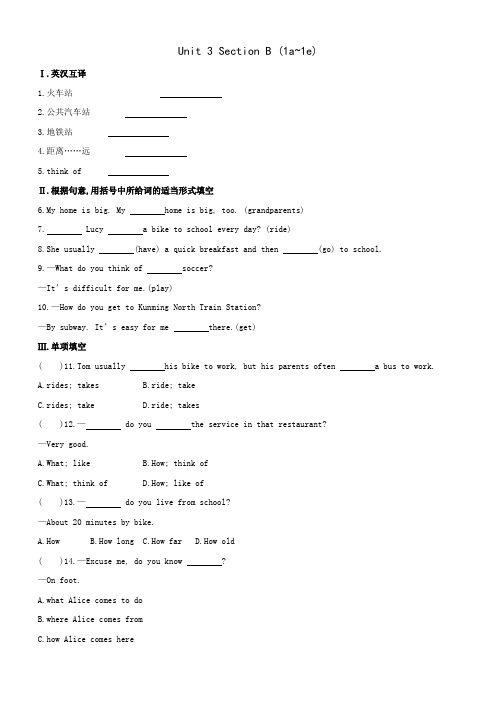
Unit 3 Section B (1a~1e)Ⅰ.英汉互译1.火车站2.公共汽车站3.地铁站4.距离……远5.think ofⅡ.根据句意,用括号中所给词的适当形式填空6.My home is big. My home is big, too. (grandparents)7. Lucy a bike to school every day? (ride)8.She usually (have) a quick breakfast and then (go) to school.9.—What do you think of soccer?—It’s difficult for me.(play)10.—How do you get to Kunming North Train Station?—By subway. It’s easy for me there.(get)Ⅲ.单项填空( )11.Tom usually his bike to work, but his parents often a bus to work.A.rides; takesB.ride; takeC.rides; takeD.ride; takes( )12.— do you the service in that restaurant?—Very good.A.What; likeB.How; think ofC.What; think ofD.How; like of( )13.— do you live from school?—About 20 minutes by bike.A.HowB.How longC.How farD.How old( )14.—Excuse me, do you know ?—On foot.A.what Alice comes to doB.where Alice comes fromC.how Alice comes hereD.how does Alice come here( )15.It me fifteen minutes the park.A.takes; get toB.takes; to get toC.take; to get toD.take; get to( )16.— does it take you to finish your homework every day?—About two hours.A.How farB.How longC.How muchD.How manyⅣ.按要求完成下列各题17.Jane goes to school by subway.(改为一般疑问句)Jane to school by subway?18.It’s thirty minutes’ walk from the post office to my home.(对画线部分提问)is it from the post office to your home?19.It takes her half a day to draw this picture.(对画线部分提问)does it take her to draw this picture?20.Mr. Miller usually walks to the supermarket.(改为同义句)Mr. Miller usually goes to the supermarket .21.I often spend an hour getting there.(改为同义句)It often me an hour get there.Ⅴ.根据短文内容,从方框中选择恰当的单词并用其适当形式填空brush, get, after, ask, job,she, with, never, make, butRita is a nice girl. She has an interesting 22. . She works at a radio station. She is busy 23. happy every day. In the morning she 24. up early. First she helps her mother 25. breakfast. Then she 26. her teeth and eats breakfast. 27. that she goes to work. Rita is 28. late for work. She likes 29. job. And she is good 30. her workmates(同事) at the radio station. After work, her workmates often 31. her to have dinner with them. But Rita likes to get home early and have dinner with her parents.答案Ⅰ.1.train station2. bus station/bus stop3. subway station4. far from5.认为;想起Ⅱ.6.grandparents’7. Does; ride8. has; goes9. playing10.to getⅢ.11.C 考查主谓一致。
人教七年级下册英语Unit3SectionB同步练习(含解析)

Unit3Section B基础闯关全练I.根据句意和汉语提示写出所缺的单词1.Look at the(桥)over there.lt is very beautiful.2.One day my(梦想)will come true.3.The little girl is(害怕)of dogs.4.There is a(河)near here.5.1can see some(小船)on the coast.There will be a high-speed railway,(在...之间)Ningbo and Zhoushan. 6.II.用括号中所给词的适当形式填空1.The(village)dreams to leave the village to work in the big city.2.Be careful when you go(cross)the street.3.It's very easy(find)some useful information on the Internet.4.He doesn't want to tell me the(true).5.It usually takes me ten minutes(ride)to school.III.单项选择1.()John likes to sit between his father his mother.A.andB.orC.atD.in2.()It's very dangerous for us the mobile phone while crossing the street.A.answeringB.to answerC.answer3.()1have homework to do and Julie has books to read.A.much;manyB.many;manyC.many;muchD.much;much4.()It takes ten minutes his homework.A.his;doB.him;to doC.his;doingD.him;do5.()It's the old man's dream to go to Beijing.Can his dream?A.go outB.eat oute truee on6.()Susan,is important to practice speaking English after class.A.itB.oneC.thatD.this7.()It's hard for us to say goodbye we have so many happy days to remember.A.soB.becauseC.althoughD.until能力提升全练I.根据汉语意思完成句子,每空一词1.如果你足够努力,梦想就会实现。
人教版英语七年级下册Unit3SectionB(2a~2d)优秀教学案例

4.反思与评价:本案例引导学生进行自我反思和评价,培养了他们的自我认知能力和自我改进的能力。通过反思与评价,学生能够更好地发现自己的优点和不足,提高学习效果。同时,互评和小组评价也能够让学生从不同角度获取反馈,提高他们的综合能力和批判性思维。
(三)学生小组讨论
1.让学生分成小组,讨论自己喜欢的国家饮食文化,并分享给其他小组。
2.鼓励学生用英语进行讨论,提高他们的语言运用能力和合作能力。
3.各小组汇报讨论成果,让其他学生学习和交流,扩大他们的视野。
(四)总结归纳
1.引导学生总结本节课所学的内容,包括对话内容、词汇和句型等。
2.总结不同国家的饮食文化特点,让学生认识到文化差异,培养他们的跨文化交际能力。
三、教学策略
(一)情景创设
1.利用多媒体展示不同国家的美食图片,引发学生的兴趣和好奇心,激发他们的学习动力。
2.设计角色扮演活动,让学生模拟不同国家的饮食文化场景,增强他们的实际语言运用能力。
3.创设情境,让学生置身于真实的跨文化交流环境中,培养他们的文化意识和交际能力。
(二)问题导向
1.引导学生提出问题,激发他们的思考和探究欲望,培养他们的批判性思维能力。
2.通过问题驱动,引导学生深入分析对话内容,发现语言规律和文化差异,提高他们的观察力和分析能力。
3.设计问题链,引导学生从不同角度思考问题,培养他们的逻辑思维和综合能力。
(三)小组合作
1.组织学生进行小组讨论,鼓励他们分享自己的想法和观点,培养他们的合作能力和团队精神。
Unit 3SectionB2a-2d教案2021-2022学年人教版英语七年级下册
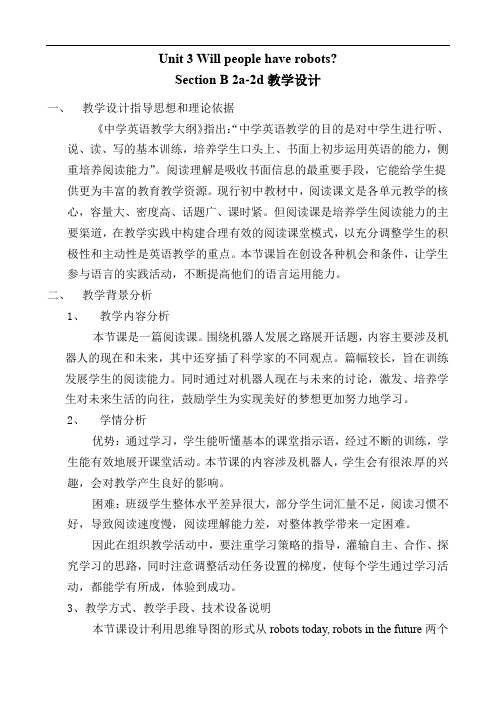
Unit 3 Will people have robots?Section B 2a-2d教学设计一、教学设计指导思想和理论依据《中学英语教学大纲》指出:“中学英语教学的目的是对中学生进行听、说、读、写的基本训练,培养学生口头上、书面上初步运用英语的能力,侧重培养阅读能力”。
阅读理解是吸收书面信息的最重要手段,它能给学生提供更为丰富的教育教学资源。
现行初中教材中,阅读课文是各单元教学的核心,容量大、密度高、话题广、课时紧。
但阅读课是培养学生阅读能力的主要渠道,在教学实践中构建合理有效的阅读课堂模式,以充分调整学生的积极性和主动性是英语教学的重点。
本节课旨在创设各种机会和条件,让学生参与语言的实践活动,不断提高他们的语言运用能力。
二、教学背景分析1、教学内容分析本节课是一篇阅读课。
围绕机器人发展之路展开话题,内容主要涉及机器人的现在和未来,其中还穿插了科学家的不同观点。
篇幅较长,旨在训练发展学生的阅读能力。
同时通过对机器人现在与未来的讨论,激发、培养学生对未来生活的向往,鼓励学生为实现美好的梦想更加努力地学习。
2、学情分析优势:通过学习,学生能听懂基本的课堂指示语,经过不断的训练,学生能有效地展开课堂活动。
本节课的内容涉及机器人,学生会有很浓厚的兴趣,会对教学产生良好的影响。
困难:班级学生整体水平差异很大,部分学生词汇量不足,阅读习惯不好,导致阅读速度慢,阅读理解能力差,对整体教学带来一定困难。
因此在组织教学活动中,要注重学习策略的指导,灌输自主、合作、探究学习的思路,同时注意调整活动任务设置的梯度,使每个学生通过学习活动,都能学有所成,体验到成功。
3、教学方式、教学手段、技术设备说明本节课设计利用思维导图的形式从robots today, robots in the future两个方面梳理文章脉络,并指导学生用思维导图来复述文章,锻炼学生的归纳总结和语言表达能力。
运用“讨论-限时自读-导读-复读-讨论”的基本课堂教学模式,设计学生学习活动。
最新人教PEP版七年级下册英语Unit 3 SectionB (3a-Self Check)-课后作业
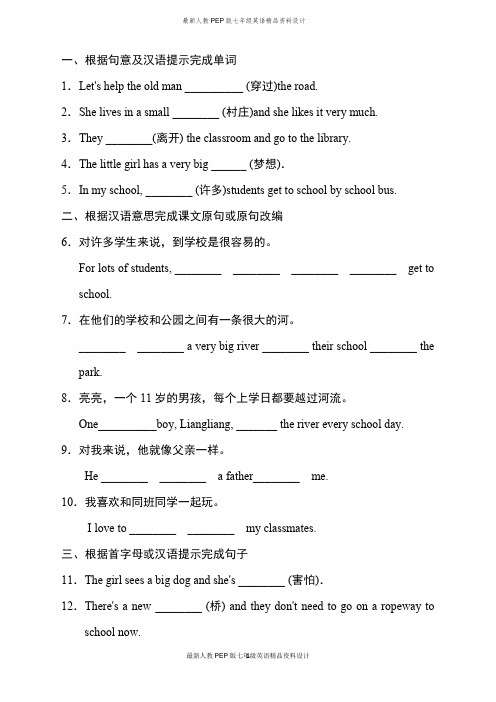
一、根据句意及汉语提示完成单词1.Let's help the old man __________ (穿过)the road.2.She lives in a small ________ (村庄)and she likes it very much.3.They ________(离开) the classroom and go to the library.4.The little girl has a very big ______ (梦想).5.In my school, ________ (许多)students get to school by school bus.二、根据汉语意思完成课文原句或原句改编6.对许多学生来说,到学校是很容易的。
For lots of students, ________ ________ ________ ________ get to school.7.在他们的学校和公园之间有一条很大的河。
________ ________ a very big river ________ their school ________ the park.8.亮亮,一个11岁的男孩,每个上学日都要越过河流。
One__________boy, Liangliang, _______ the river every school day. 9.对我来说,他就像父亲一样。
He ________ ________ a father________ me.10.我喜欢和同班同学一起玩。
I love to ________ ________ my classmates.三、根据首字母或汉语提示完成句子11.The girl sees a big dog and she's ________ (害怕).12.There's a new ________ (桥) and they don't need to go on a ropeway to school now.13.The story is t________.We are all moved(感动) by it.14.It usually takes me ten minutes to walk to the bus ________ (车站).15.They live in an island(岛屿) and they go to school by b________.四、用方框中所给词的适当形式填空year, dream, village, cross, grandparents16.Her ________ is to be a star.17.The little horse(小马)wants ________ the river.18.Many ________ there have cars now.19.Old Henry is seventy ________ old, but he can run very quickly. 20.My ________ home is far from our home.五、用所给词的适当形式填空21.It's easy for them ________ (speak)English well.22.Please don't ________(across) the street when the light is red.23.(中考•绥化)It is quite fine today! How about ________ (go) climbing this afternoon?24.(中考•遵义)Let's stop ____________ (exercise) unhealthily, and we can make a better life.25.All the ________ (village)homes are big and clean.六、单项选择26.—There is no bridge over the river. How can we it?—By boat.A.draw B.find C.clean D.cross27.(中考•乐山)—What do you ________ the Korean TV series My Love From Another Star?—Pretty good. It is popular with many people.A.care for B.hear about C.think of28.—I often have hamburgers for lunch.—You'd better not. It's bad for you ________ too much junk food.A.eat B.to eat C.eating D.ate29.(2016•重庆B改编)The environment(环境) here becomes better and better(越来越好).________ birds are coming back.A.Thousands of B.Thousand ofC.Thousands D.Thousand30.Zhang Lei likes tennis and her dream is to be a tennis star ____ Li Na.A.like B.with C.for D.about31.I walk to school every day.________you?A.How are B.What aboutC.How old are D.What are32.Lin Fen ________ home ________ school at 7:30 every morning.A.gets; for B.gets; toC.leaves; for D.leaves; from33.We have a ________ holiday every National Day.A.7 day B.7days C.7day D.7 day's34.(中考•益阳) She wants to know ________.A.what your mother does B.how old are youC.where are you from35.How kind you are! You always do what you can ________ others.A.help B.helping C.helps D.to help七、按要求完成下列各题36.(2015•重庆B)努力学习,你的梦想一定会实现。
初中英语 七年级下册 Unit3 How to get to school

Exercise
一、根据句意及汉语提示完成单词。
1.Helen wants to go to Shanghai next ___y_e_a_r__(年). 2.Mr. Smith likes to live in the small __v_il_l_a_g_e__(村庄). 3.I sit __b_e_t_w__e_e_n__(介于……之间) my parents. 4.My ____d_r_e_a_m___(梦想) is to be a musician like Lang Lang. 5.Alan __l_e_a_v_e_s_(离开) home and goes to school at 7:00 every
A. takes B.makes C.needs D.asks
( B )3.—What do you ________ the TV show?
—It's boring. I don't like it.
A. cotalk to
D.play with
( C )4.I don't know ________.Can you tell me?
√1.
2.
原文:
Mary: I love your home, Bob. It’s so big! Bob: Thanks, Mary. My grandparents’ home is very big, too.
Mary: Where do they live? Bob: Very far from my home.
Mary: How do you get there? Bob: I usually take the train.
Mary: How long does it take? Bob: It takes about six hours. And then I take a bus from the train station to their home.
人教版七年级英语下册Unit3SectionB重难点突破教学设计
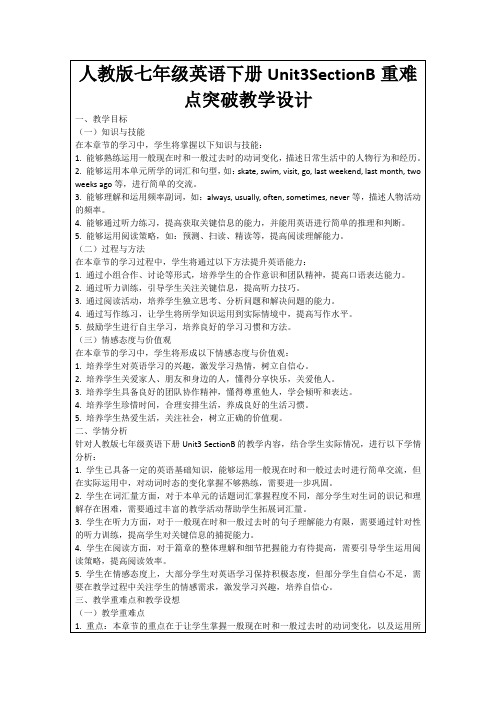
(五)总结归纳
1.教师邀请学生回顾本节课所学内容,总结一般现在时和一般过去时的动词变化规律,以及频率副词的用法。
2.教师引导学生分享学习收获,鼓励学生用英语进行表达,提高口语能力。
3.教师对学生的课堂表现进行评价,强调学习英语的重要性,激发学生学习兴趣,培养自信心。
b.引导学生关爱他人,学会分享,培养良好的团队协作精神。
四、教学内容与过程不同人物在周末或假期时的活动场景,如:skateboarding, swimming, visiting grandparents等,引导学生观察并预测本节课的话题。
2.教师邀请学生分享自己的周末或假期经历,让学生尝试用英语进行简单描述,为新课的学习做好铺垫。
3.听力训练,分层指导:针对学生的听力水平,设计不同难度的听力练习,分层指导,提高学生的听力技巧。
a.教师可以播放一段关于人物周末活动的听力材料,让学生回答问题,锻炼捕捉关键信息的能力。
b.听力训练中,教师引导学生关注频率副词,进行简单的推理和判断。
4.阅读策略,指导实践:在阅读活动中,教师引导学生运用阅读策略,如:预测、扫读、精读等,提高阅读理解能力。
3.各小组选取一名代表进行汇报,其他组成员倾听并给予评价,教师巡回指导,及时纠正错误,引导学生正确运用所学知识。
(四)课堂练习
1.教师设计一份包含一般现在时和一般过去时的动词填空练习,让学生完成并互相批改,巩固所学知识。
2.教师设计一份听力练习,让学生听一段对话,回答问题,锻炼听力技巧,提高关键信息捕捉能力。
5.培养学生热爱生活,关注社会,树立正确的价值观。
二、学情分析
针对人教版七年级英语下册Unit3 SectionB的教学内容,结合学生实际情况,进行以下学情分析:
Unit 3 Section B(1a-1d)七年级英语下册(人教版)
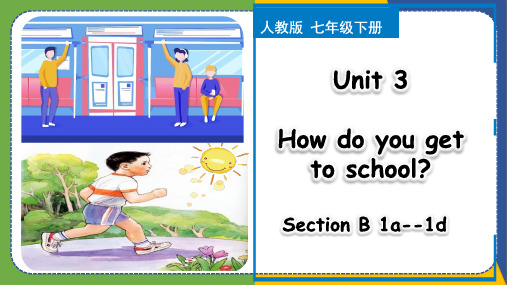
2. 宾语从句
Language points 语言点
充当宾语成分的句子叫宾语从句,常置于动词、介词、形容词后作 宾语成分,并由连接副词(when,where,wht,how……)连接。 宾语从句要用陈述语序。
Mary wants to know where Bob lives.
Bob: Yes, it is. So I go there and see my grandparents only one or two times a year.
Mary: How do you get there?
一年两次
Bob: I usually take the train.
Mary: How long does it take?
Mary wants to know how far he lives from his grandparents’ home.
Mary wants to know how he gets to his grandparents’ home.
Mary wants to know how long it takes to get to his grandparent’s home.
Then I take the subway.
1b Tell your partner how you get to school. Imagine you use
two types of transportation.
TAXI
A: How do you get to school? B: First, I …
How far is it (from your home to school)?
【同步练习卷】人教版英语七年级下册 Unit3 Section B
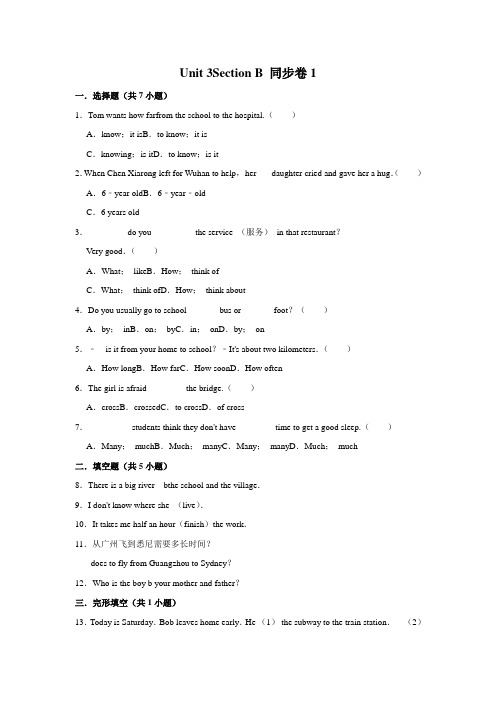
Unit 3Section B 同步卷1一.选择题(共7小题)1.Tom wants how farfrom the school to the hospital.()A.know;it isB.to know;it isC.knowing;is itD.to know;is it2.When Chen Xiarong left for Wuhan to help,her___ daughter cried and gave her a hug.()A.6﹣year oldB.6﹣year﹣oldC.6 years old3._________do you _________ the service (服务)in that restaurant?Very good.()A.What;likeB.How;think ofC.What;think ofD.How;think about4.Do you usually go to school _______bus or _______foot?()A.by;inB.on;byC.in;onD.by;on5.﹣is it from your home to school?﹣It's about two kilometers.()A.How longB.How farC.How soonD.How often6.The girl is afraid ________ the bridge.()A.crossB.crossedC.to crossD.of cross7.________ students think they don't have ________ time to get a good sleep.()A.Many;muchB.Much;manyC.Many;manyD.Much;much二.填空题(共5小题)8.There is a big river bthe school and the village.9.I don't know where she (live).10.It takes me half an hour(finish)the work.11.从广州飞到悉尼需要多长时间?does to fly from Guangzhou to Sydney?12.Who is the boy b your mother and father?三.完形填空(共1小题)13.Today is Saturday.Bob leaves home early.He (1)the subway to the train station.(2)does he want to go?Bob's grandma (3)in Maple Town.Bob likes to see her.Mom is busy,so she can't go with Bob.But Bob is not (4)His grandma will meet him at the Maple Town Station.Maple Town is 113 kilometers away (5)the city.It takes Bob about two (6)to get there by train.It's not boring on the train.Bob takes the phone with him,(7)he can play games and listen to music.Time goes (8).At 11:05 am,the train get's to the Maple Town Station.Bob takes his bag and gets off the train.Many (9)are at the station,but Bob sees his grandma quickly.He is very happy and (10)to her.Have a good time in Maple Town,Bob!(1)A.needs B.drives C.takes D.sees(2)A.Where B.How C.What D.When(3)A.comes B.dances C.plays D.lives(4)A.free B.afraid C.happy D.late(5)A.to B.in C.at D.from(6)A.hours B.minutes C.weeks D.months(7)A.or B.so C.but D.when(8)A.quickly B.far C.really D.never(9)A.friends B.trains C.people D.villagers(10)A.thinks B.gives C.takes D.runs四.阅读理解(共1小题)14.(1)Where may you find this picture?A.In a classroom.B.At an underground station.C.On a bus.D.In a hospital.(2)How many lines does this picture show us?A.Three.B.Four.C.Two.D.Five.(3)Julia is at Roosevelt.She wants to go to Baseball Field.She should change the line at .A.GrandB.ClitonC.RenoD.Randolph(4)To go to Airport from Youth Centre,you should take lines in this order: .A.Blue Line→Green Line→Red LineB.Red Line→Green Line→Blue LineC.Blue Line→Red Line→Green LineD.Red Line→Blue Line→Green Line五.书面表达(共1小题)15.Write about how Bob gets to his grandparents' home?Bob's home is very big. But his grandparents' home is bigger.______Unit 3Section B 同步卷1参考答案与试题解析一.选择题(共7小题)1.Tom wants how farfrom the school to the hospital.()A.know;it isB.to know;it isC.knowing;is itD.to know;is it【分析】汤姆想知道从学校到医院有多远。
七年级英语下册Unit3 SectionB 1a-1e课件
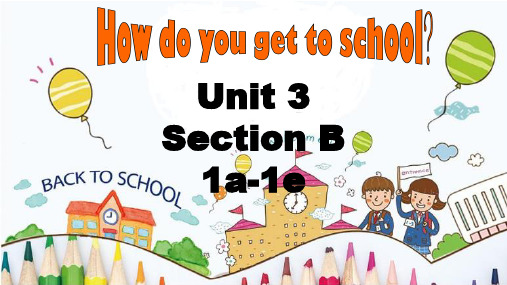
How do you get to school?
LJ1ais.naHe ::oIHwuoswduoafaellrsyiJstaaiktnefertohgmeetbyoutous.rsc+hgoeot tloesvcheoroyl bdy bauys?.
L2is.aH:ohIw'ommdneootetosssuLcrheiso…aolg?aebtoutot school?
_√__ how far he lives from his grandparents’ home. _√__ how he gets to his grandparents’ home. __√_ how long it takes to get to his grandparents’ home.
She rides a bike./By bike. 2. How does Lisa get to school?
She usually takes a bus./By bus.
3. How far is it from Lisa’s home to school? About ten kilometers.
Lisa: Yeah. Well, have a good day at school.
Jane: You, too.
2e
Post-listening
Read the conversation in 2e and answer the questions. 1. How does Jane get to school every day?
Lead in Where can you find these vehicles?
train
train station
人教版七年级英语下册Unit 3 Section B(1a-1c) (PPT15张)
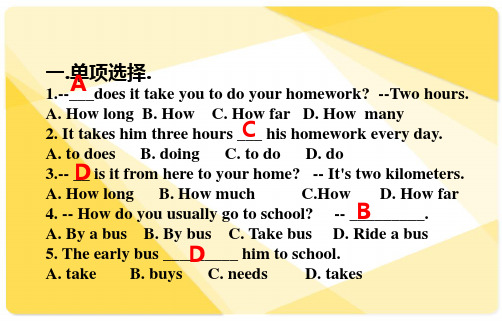
➢学习内容:3c
➢方法提示: 1.live about five kilometers from school 离家住的大约5公里 2.need about 10 minutes to get to school 需要大约10分钟到达学校
交通方式总 结:
1.动词表示交通工具:
①.主语+take a/the +交通工具(单数) to+地点。
A. to does B. doing C. to do D. do
3.-- _D_ is it from here to your home? -- It's two kilometers.
A. How long B. How much
C.How D. How far
4. -- How do you usually go to school? -- _B________.
2.--__have you lived with your grandparents?
-- About three years.
A. How far B. How C. How long D. How much
3.-- _____ does your mother go to work?
-- By bus.
一1.--._单A__项do选es 择it t.ake you to do your homework? --Two hours.
- 1、下载文档前请自行甄别文档内容的完整性,平台不提供额外的编辑、内容补充、找答案等附加服务。
- 2、"仅部分预览"的文档,不可在线预览部分如存在完整性等问题,可反馈申请退款(可完整预览的文档不适用该条件!)。
- 3、如文档侵犯您的权益,请联系客服反馈,我们会尽快为您处理(人工客服工作时间:9:00-18:30)。
PS:1.be afraid of 害怕某事 翻译:我不害怕鬼。 I am not afraid of ghost. 2.一个三间屋的房子 a three rooms house a three-room-house
“ I love to(喜爱做某事) play with my classmates.
2a. Look at the picture and title below. Guess what the passage is about.
Crossing the River to School
2b
Crossing the River to School How do you get to school? Do you walk or ride a bike? Do you go by bus or by train? For(对于) many students ,it is easy to(容易做某事) get to school. But for the students in(在)one small village in China, it is difficult.
river 河;江
boat 小船
bridge 桥
village 村庄; 村镇
villager 村民
ropeway 索道
100 分
leave dream 梦想;做梦 离开
between …之间
cross 横过;越过
afraid 害怕;畏惧
many 许多
bus stop(停车点)
bus station (停/转换车辆的车站)
subway station
train station
1a. Match the words with the pictures.
1._b_bus stop
3._c__ bus station
2.__a_train station 4. _d__subway station
1b. Pairwork
2.这有好多书 There a_r_e__ _s_o__ma_n_y___books.
3.A在B和C的中间。 __A__i_s__b_e_t_w_e_e_n__B__a_n_d__C___________.
One 11-year-old boy, Liangliang, crosses the river every school day(每一个上学的日子). But he is not afraid(不害怕) because he loves school.
And I love my teacher. He’s like(像) a father to(对)
me.”Many of(...中的许多) the students and villagers
never leave the village. It is their dream to have a
bridge. Can their dream come true?(实现)
Mary wants to know… ___ where Bob lives.
_√__ how far he lives from his grandpa how he gets to his grandparents'home. _√__ how long it takes to get to his
A: How do you get to school? B: Well, I ride my bike to(到达)the subway
station. Then I take the subway.
1b. Pairwork
A: 你是怎么来学校的? _H_o_w__d_o__y_o_u__g_e_t__t_o__s_c_h_o_o_l_?_____?
grandparents’home. ___ what he thinks of(认为,觉得) the trip.
1d. Listen again. How does Bob get to his grandparent’home? Check ( ) 1 or 2.
√
1e Talk about how Bob gets to his grandparents’home.
So these students go on a ropeway(滑铁索)to(为了)
cross the river to(到) school.
PS:1.There be+单数/复数 2.between...and...在...中间
Exercise:1.这有一本书 There _i_s____ a book.
There is a very big river between their school and
the village.(between..and..在...之间----指两者)
There is no bridge and the river runs(流淌)too(太...)
quickly for boats.
B: 我搭公车来到火车站,然后搭火车。 Well, I t_a_k_e_t_h_e_ __b_u_s_ __t_o__(到达) the train station. Then I t_a_k_e_ t_h_e__ _t_r_a_i_n.
1c. Listen and check the things that Mary wants to know.
1.Bob是怎么样到达他祖父母家的?
How d_o_e__s_ Bob _g_e_t_ _t__o his grandparents’home.
2.他先搭火车到达汽车站,再搭汽车到达的。
He _t_a_k_e_s__t_h_e__t_r_a_i_n__ to the bus station. Then he_t_a_k_e__s_ _t_h_e_ _b_u_s_.
